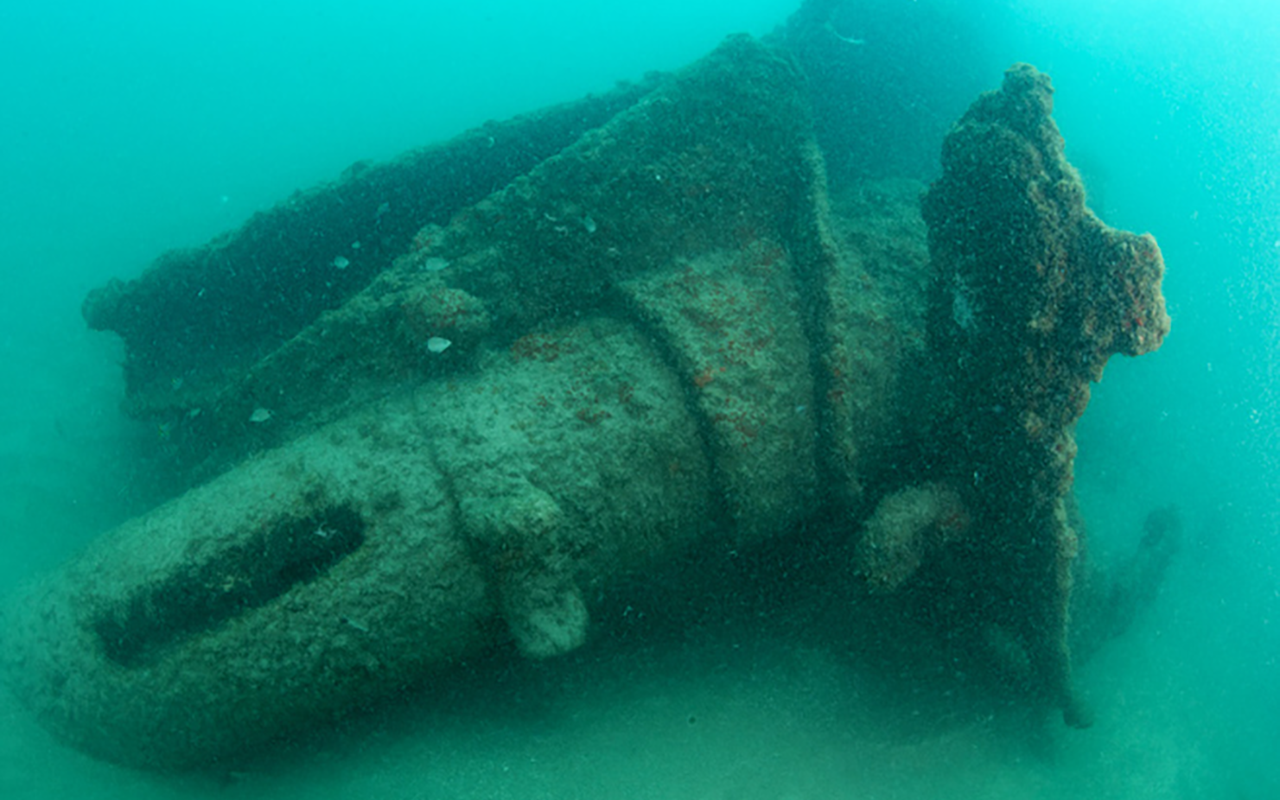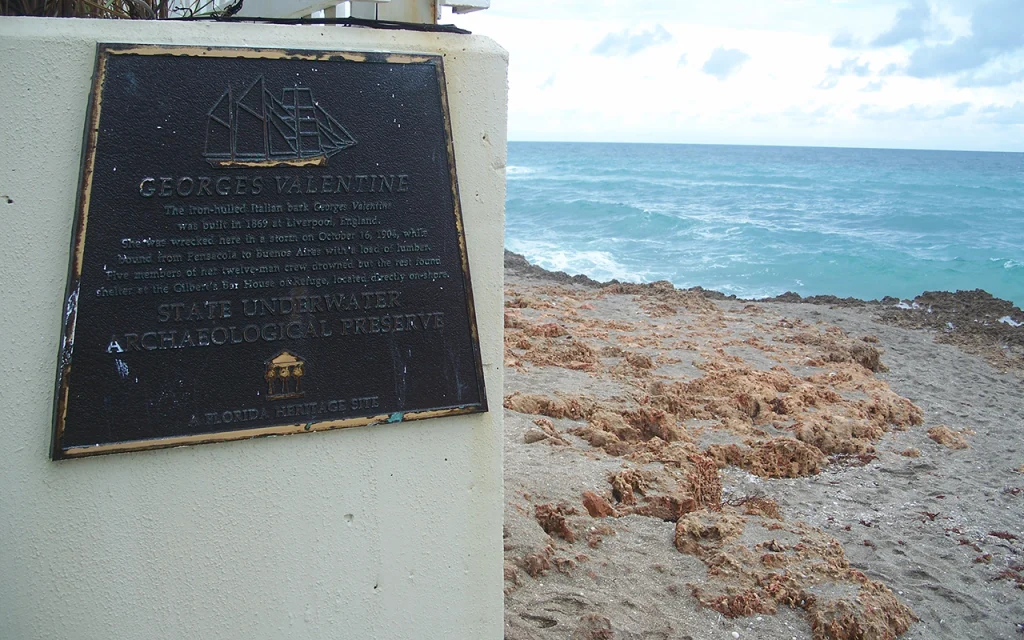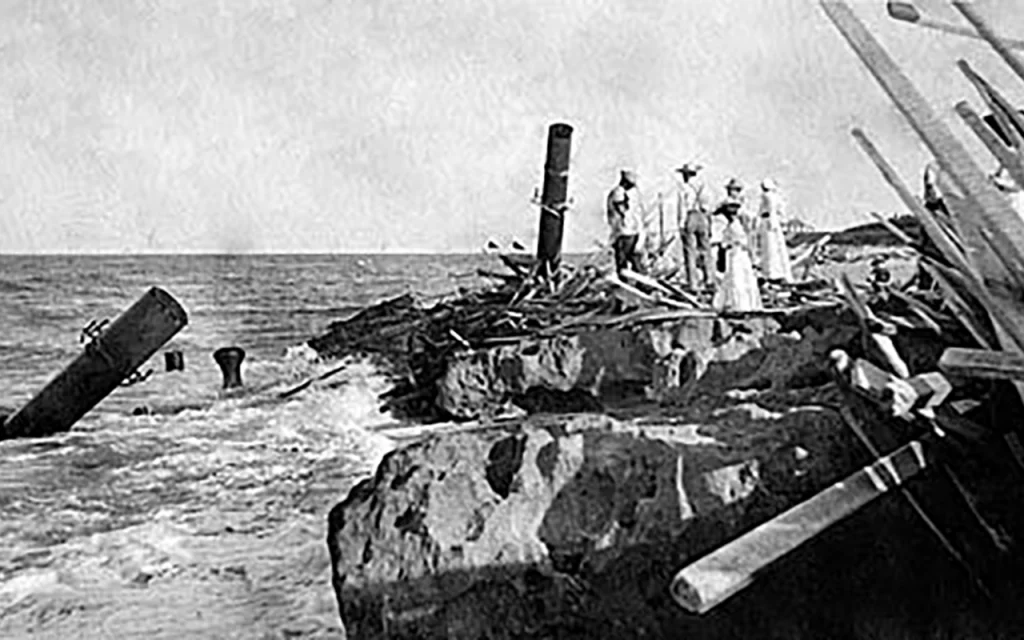Table of Contents

The Georges Valentine was an Italian barkentine that sank off the coast of Hutchinson Island in Martin County, Florida in the late 19th century. The shipwreck site is now one of Florida’s Underwater Archaeological Preserves, allowing visitors to explore the wreck through diving or snorkeling.
Article at a Glance
- Location: 100 yards offshore from the House of Refuge at Gilbert’s Bar, Hutchinson Island, Martin County, Florida
- Depth: 10-15 feet, making it accessible for both snorkelers and divers
- History: Italian barkentine that sank on October 16, 1904, during a hurricane
- Wreck Features: Broken into five main sections, including the boiler, deck plates, and hull sections
- Marine Life: Home to various fish species, including snook, sheepshead, and angelfish
- Accessibility: Easy shore entry from the beach near the House of Refuge Museum
- Designation: Florida Underwater Archaeological Preserve and listed on the National Register of Historic Places
Georges Valentine Shipwreck Location Coordinates and Depth
Depth
The wreck rests in shallow water, approximately 100 yards offshore from the House of Refuge at Gilbert’s Bar. The site is accessible for both diving and snorkeling, with various sections of the ship visible, including the boiler, deck, and hull plates.
Location Coordinates
The Georges Valentine shipwreck is located off the coast of Hutchinson Island in Martin County, Florida. The coordinates for the wreck site are:
- Latitude: 27° 11.93′ N
- Longitude: 80° 09.88′ W

What to Scuba Divers Say About This Ship
- It is considered a “MUST DO” dive while the wreck remains uncovered and accessible. Local dive shops provide information and brochures about the wreck to divers.
- Divers can park at the nearby House of Refuge Museum and easily access the wreck site, which is only 100 yards offshore in shallow 22 feet deep water.
- The wreck is broken into five prominent sections spread over a large area, allowing divers to explore different parts of the site. Depending on sand coverage, divers can even swim through some sections.
- The wreck is home to abundant marine life including snook, angelfish, sheepshead, moray eels, wrasse, and soft corals. Divers enjoy seeing the variety of sea creatures that have made the wreck their habitat.
- While the wreck’s history is tragic, with five crewmen losing their lives, divers appreciate being able to visit this “monument to the past” and final resting place of those sailors. They aim to be respectful by taking only photos and leaving only bubbles.
- The site offers a new adventure with every visit, as sand migrates to cover or expose different sections of the wreck. Divers can experience the site differently each time they dive it.
What Kind of Marine Life Can Be Found on The Ship
- Snook
- Sheepshead
- Margate
- Angelfish
- Moray eels
- Stingrays
- Lobsters
- Stone crabs
- Hermit crabs
- Puffer fish
- Triggerfish
- Parrotfish
- Wrasse
- Snapper
- Various species of soft corals
Key Information
| Category | Information |
|---|---|
| Ship Name | Georges Valentine |
| Ship Type | Italian barkentine |
| Sinking Date | October 16, 1904 |
| Cause of Sinking | Hurricane |
| Location | 100 yards offshore from House of Refuge at Gilbert’s Bar, Hutchinson Island, Martin County, Florida |
| Coordinates | 27° 11.93′ N, 80° 09.88′ W |
| Depth | 10-15 feet |
| Visibility | Generally good, can vary |
| Wreck Features | Five main sections: boiler, deck plates, hull sections |
| Marine Life | Snook, sheepshead, angelfish, moray eels, soft corals |
| Access | Shore entry from beach near House of Refuge Museum |
| Best Time to Dive | Year-round, but summer offers calmer conditions |
| Designation | Florida Underwater Archaeological Preserve, National Register of Historic Places |
| Special Notes | Sand migration can expose or cover different parts of the wreck |
What Makes Georges Valentine a Unique Diving Experience
- Accessibility: The wreck is located only 100 yards offshore from the House of Refuge, making it easily accessible for both divers and snorkelers. Parking is available at the House of Refuge, and the entry point is a rocky outcropping just south of the parking area.
- Shallow Water: The wreck rests in shallow water, typically around 22 feet deep, which makes it suitable for both experienced and novice divers.
- Changing Environment: The wreck is partially buried in sand, which migrates to and from the site depending on seasonal weather and storms. This means that the dive site changes dramatically over time, providing a new adventure with every visit.
- Marine Life: The wreck is home to a diverse array of marine life, including snook, sheepshead, margate, angelfish, kingfish, shiners, shark, moray eels, stingrays, lobster, stone crab, hermit crab, puffer, trigger, parrotfish, wrasse, snapper, and various species of soft corals.
- Historical Significance: The Georges Valentine is recognized as an underwater archaeological preserve, making it a crime to damage or remove any artifacts. This adds a layer of historical importance and respect to the dive experience.
- Variety of Dive Experience: The wreck is broken into five prominent sections, allowing divers to explore different parts of the site. Depending on sand coverage, divers can even swim through some sections.
What is The Full History of This Ship
Early History as the Cape Clear
The iron-hulled ship was originally built in 1869 in Wallasey, England by Bowdler Chaffer & Company for S. Meyers & Company. It was christened the Cape Clear and began its career as a screw steamboat carrying passengers on the Australia-Liverpool route.
Conversion to a Sailing Bark
In 1889, the ship was purchased by a French firm based in Bordeaux. They re-christened it the Cape Clear and converted it to a sailing bark by stripping it of all steam machinery except the boiler. It was then rigged as a three-masted barkentine and sold to a firm based in Dunkirk, northern France.
Ownership by Italian Firms
In 1895, the ship was sold to Mortolo & Simonetti, a firm based in Genoa, Italy. It was based in Camogli, northern Italy and used to regularly transport lumber from Pensacola, Florida to South America.
Ill-Fated Final Voyage and Sinking
In October 1904, the Georges Valentine, under the command of Captain Prospero Mortolo, sailed from Pensacola to Buenos Aires with a crew of twelve men and a cargo of milled mahogany. On October 13, the ship sighted Havana, Cuba but later encountered a storm in the Florida Straits.After being blown up the Atlantic coast of Florida for three days, the ship ran aground in shallow water and wrecked off Hutchinson Island near Gilbert’s Bar on October 16, 1904. Despite the crew’s efforts to keep the ship in deeper water, five crewmen perished. The seven survivors found refuge at the nearby House of Refuge, where the keeper, Captain William E. Rea, rendered aid to them.
Designation as a Historic Shipwreck Site
On July 19, 2006, the Georges Valentine Shipwreck Site was added to the U.S. National Register of Historic Places. Two months later, on October 16, 2006, it became the eleventh Florida Underwater Archaeological Preserve.

What Historical Features Can Still Be Identified on Georges Valentine Wreck
- Boiler: The boiler is one of the most prominent features of the wreck. It is partially buried in the sand and is a significant part of the ship’s remains.
- Hull Sections: The hull is broken into five prominent sections, which are partially buried in the sand. The sections are scattered across the seafloor, providing a glimpse into the ship’s structure.
- Mast and Framework: A large section of the upper deck with a mast on the rocks can be seen, consistent with reports written by Captain Rea in 1904. This wreckage includes the mast and framework 495 feet south of the House of Refuge.
- Tile Deck: Depending on sand coverage, the tile deck can be visible, providing a glimpse into the ship’s original structure.
- Superstructure: The superstructure of the ship is also visible, although it can be obscured by sand migration.
- Debris Field: The debris field surrounding the wreck includes various artifacts and remnants of the ship’s cargo and equipment.
What Safety Measures Are in Place for Divers Visiting Georges Valentine
- Shallow Depth: The wreck rests in relatively shallow water, typically around 22-32 feet deep, making it accessible for both experienced and novice divers.
- Proximity to Shore: The wreck is located only 100 yards offshore, allowing divers to easily access the site from the nearby House of Refuge.
- Diver-Down Flag: Divers are advised to always display a diver-down flag when diving the site to alert other boaters in the area.
- Changing Conditions: The search results note that the wreck is partially buried in sand, and the sand migrates significantly depending on weather and storms. Divers need to be aware of these changing conditions and plan their dives accordingly.
- Guided Tours: The House of Refuge Museum offers guided tours of the wreck site, providing divers with important historical context and safety information before entering the water.
- Underwater Archaeological Preserve: The Georges Valentine wreck site is designated as an Underwater Archaeological Preserve by the Florida Department of State. This means divers must follow specific guidelines to protect the historical integrity of the site.
- Avoid Damage: Divers are instructed not to remove or damage any artifacts from the wreck, as it is considered a historic site.
Dive Shops That Prove Diving Trips to This Shipwreck
- Lochaline Dive Centre: Located in Oban, Scotland, this dive center offers guided tours to the Georges Valentine wreck site.
- Florida Family Insiders: This travel vlog offers guided tours and boat charters to the Georges Valentine shipwreck off the coast of Hutchinson Island, Florida.
- House of Refuge Museum: The museum offers guided tours and information about the Georges Valentine shipwreck, which is located just 100 yards offshore from the museum.
Central Florida Wrecks
- SS Breconshire
- Georges Valentine
- Hog Heaven
- Urca De Lima
- USS Rankin
- Ana Cecilia
- United Caribbean
- USS Mindanao
- The Laertes
- Berry Patch Tug Wreck
- The Liberty Ship
- The Ana Cecilia
- The Cities Service Empire
- USS Accokeek
- The Tortuga Wreck
- Princess Ann Wreck (Palm Beach)
- Okinawa Wreck (Pompano Beach)
- MG-111 Wreck (Jupiter)
- Lady Luck Wreck (Pompano Beach)
- Rodeo 25 Wreck (Pompano Beach)
- Lowrance Wreck (Pompano Beach)
- RSB-1 Wreck (Deerfield Beach)
- Rebel Wreck (Deerfield Beach)
- Noulla Express Wreck (Fort Lauderdale)
- Sucre Wreck (Fort Lauderdale)
- Captain Tony Wreck (Pompano Beach)
- Peter McAllister Wreck (Pompano Beach)
- Guy Harvey Wreck (Fort Lauderdale)
- Quallman Tugs Wreck (Pompano Beach)
- Miller Lite Wreck (Pompano Beach)





